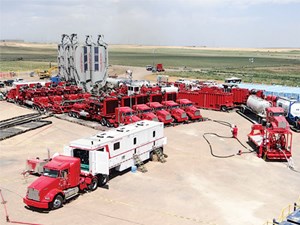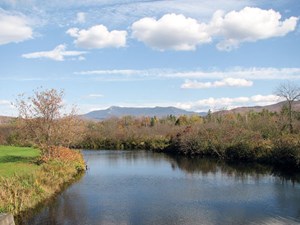Wyoming court decision could have wide-ranging future impacts
On June 21, U.S. District Judge Scott Skavdahl (U.S. District Court of Wyoming) issued a strong rebuke to the Obama regulatory agenda, ruling that efforts by the Bureau of Land Management (BLM) lack congressional authority to move ahead with its burdensome, proposed regulation on hydraulic fracturing and well completions for wells drilled on federal lands. Skavdahl, an appointee of President Barack Obama, ruled that the BLM lacks a valid governing statute under which to issue such a regulation.

Judge Skavdahl wrote that the role of the court is not to decide whether or not hydraulic fracturing (Fig. 1) is good or bad for the environment, but to interpret whether Congress has granted the BLM the legal authority to regulate this practice. “It has not,” the judge stated. Lawyers for the government argued that the BLM has the discretion to move ahead with regulation under past Supreme Court decisions and the failure of Congress to address the matter, but Judge Skavdahl ruled that a lack of congressional action does not, of itself, grant the regulator the authority to regulate.
While the Obama administration promised to file an appeal, the decision by Judge Skavdahl represents a big win for the Independent Petroleum Association of America (IPAA), the Western Energy Alliance (WEA), and the states of Wyoming, Utah, Colorado and North Dakota, all of whom had filed challenges to the proposed regulation. Those parties also were joined in the suit by a brief filed by the Ute Indian Tribe of Uintah and Ouray, which agreed that the BLM lacked rulemaking authority, and further argued that the agency lacks authority to regulate fracing on land that the U.S. holds in trust for the Indian tribes and tribal members.
If upheld on appeal, the legal principle underpinning this decision—that federal regulations must have, as a foundation, affirmative congressional statutory authorization—could have broad-ranging impacts that go well beyond efforts to regulate hydraulic fracturing and other downhole oilfield activities and practices.
WATERS OF THE U.S. EXCESSES
In the world of federal regulations that exceed the intended bounds of their cited governing statutes, EPA’s “Waters of the United States” (WOTUS) rule would have to be the obvious poster child, Fig. 2. The governing statute in this case is cited by EPA as The Clean Water Act (CWA).

Passed by Congress and signed into law by President Richard Nixon in 1972, CWA was a noble effort by the federal government to “restore and maintain the chemical, physical and biological integrity” of the nation’s lakes, rivers and streams, which had, by and large, fallen into terrible condition. The Act specifically authorizes the EPA to regulate the “navigable waters of the United States.” The clear intent of the use of that terminology was to limit EPA’s reach to such rivers, streams and lakes on which one could reliably, and consistently, float a boat. Simple, right?
Well, not to the bureaucrats at EPA, who believe it is their duty to constantly expand their agency’s reach. Such federal employees—working in conjunction with, and at the behest, of radical “environmentalist” groups—in several different administrations over the years have engaged in repeated efforts to expand the definition of what this term means. WOTUS is the latest, and most ambitious, such effort.
WOTUS was finalized in 2015, but it was challenged immediately by about a dozen states, and a wide array of business interests. In late 2015, a federal judge issued a stay that has, since that time, prevented the EPA from moving forward with enforcement efforts. The reason for that stay is obvious: WOTUS represents such a radical departure from established law, and such a vast expansion of the federal government’s regulatory reach, that the judge believes it should not be subject to enforcement until the courts have ruled.
Under WOTUS, EPA’s reach on what it considers to be “navigable waters” would be extended to any creek, trench, pond, ditch or puddle—whether naturally occurring or man-made, whether permanent, temporary, seasonal or “ephemeral”—that could, in some way, shape or form cause runoff water to be carried into what actually is a permanent, navigable water. Now, some of you may think that is perfectly reasonable, but let me give you just one of thousands of examples of why it is not.
I live in the City of Houston and, upon moving here 12 years ago, quickly learned that the city’s leaders, over the decades, had the vision to intentionally design the surface streets to carry rainwater during our frequent torrential downpours. This rainwater flows into the five bayous that run through the city and, ultimately, carry water out into Galveston Bay. In other words, Houston’s city streets become temporary drainage ditches when the rains come.
Well, guess what? Under WOTUS, this means that Houston’s surface streets would be considered to have “nexus” with real “navigable bodies of water”—the Bayous—and thus would be subject to regulation by EPA. If you think it is hard, costs too much and takes a long time to get potholes filled by your local city government, just wait until the construction, design and maintenance of your city’s streets are governed by EPA bureaucrats sitting in offices 1,200 mi away.
It’s not just Houston. Hundreds, if not thousands, of cities and towns across this country design their streets to carry off rainwater in this manner.
No doubt, many will read this and think, “he’s just speculating—that’ll never happen.” Don’t kid yourself that way—that’s exactly what millions of Americans thought 20 years ago, when radical environmentalists began to advocate for EPA regulation of plant food—carbon dioxide—as a “pollutant.” That’s what many people in Alaska said, when the Polar Bear, whose population had increased 400% since the 1950s, was proposed in the early 2000s for listing as an endangered species.
Far from being mere speculation, this is, in fact, an inevitable outcome, should the courts allow WOTUS to go into effect in its current form. It is an inevitable outcome not by accident, but because the language in WOTUS would so clearly authorize EPA to proceed in this manner. The number-one thing to understand about the nature of federal regulatory bureaucracies is that power is job security.
Thus, all federal bureaucracies will always expand their regulatory reach as broadly as they possibly can. It might be five, ten years down the road, when EPA gets around to calling the director of the City of Houston Department of Public Works, to inform him or her that their services will no longer be needed, but that day will come.
Clearly, WOTUS would expand EPA’s reach vastly beyond any reasonable notion of what Congress has affirmatively authorized. This brings us back to the very sound, fundamental legal principle that underpins Judge Skavdahl’s decision on the BLM hydraulic fracturing rule. If his reasoning stands the test of the appellate process, the potential application to WOTUS is obvious.
OTHER POTENTIALLY IMPACTED REGULATIONS
One also might speculate that this same legal reasoning could be applied ultimately to a wide array of Obama administration “climate plan” regulations. EPA’s ever-expanding definition of “aggregation” of sources under the Clean Air Act comes immediately to mind, as does the current effort by the federal Pipeline and Hazardous Materials Safety Administration (PHMSA) to expand its interstate pipeline safety regulations to field gathering systems, all the way back to the wellhead.
Then we have the whole “sue and settle” scam related to the Endangered Species Act. This is the racket in which radical anti-development groups like EarthJustice (EJ) and the Center for Biological Diversity (CBD) overwhelm the resources of the U.S. Fish and Wildlife Service (USFWS) by simultaneously filing hundreds of nominations for listings under the Endangered Species Act (ESA). Inevitably, USFWS is unable to meet its deadline for filing a response to many of the listings, at which time the anti-development groups file suit in federal court. After a sham “negotiation,” the government then settles out-of-court with EJ or CBD, and reimburses them for their “legal fees” and other costs of pursuing the listing.
Between 2001 and 2012, USFWS paid out more than $22 million to these groups in response to their scam lawsuits. Obviously, Congress never had any intention of USFWS participating in this sort of racket under the language contained in the Endangered Species Act.
THE FINAL DECISION
Ultimately, of course, the appellate process related to the BLM hydraulic fracturing and well completions rule could go all the way to the Supreme Court over the next few years, and the final decision might depend largely upon how the presidential race sorts out this November.
Should the district court decision be upheld by the appellate court, a Hillary Clinton administration would almost certainly appeal the case to the nation’s highest court. Given that, by that time, Clinton would have presumably succeeded in having her own nominee confirmed to become the ninth justice, a positive outcome for the BLM would seem to be most likely. However, a Donald Trump victory in November could result in an appointee who, as the ninth vote, might tip the scales in Judge Skavdahl’s favor, in a potential 5-4 decision. Should the appellate court rule in favor of the government, the same speculative logic could be applied in the opposite direction.
Regardless of how this ultimately comes out, June 21, 2016, was a day on which opponents of the constantly expanding regulatory reach of the federal government were able to raise a toast to a very significant victory. ![]()


